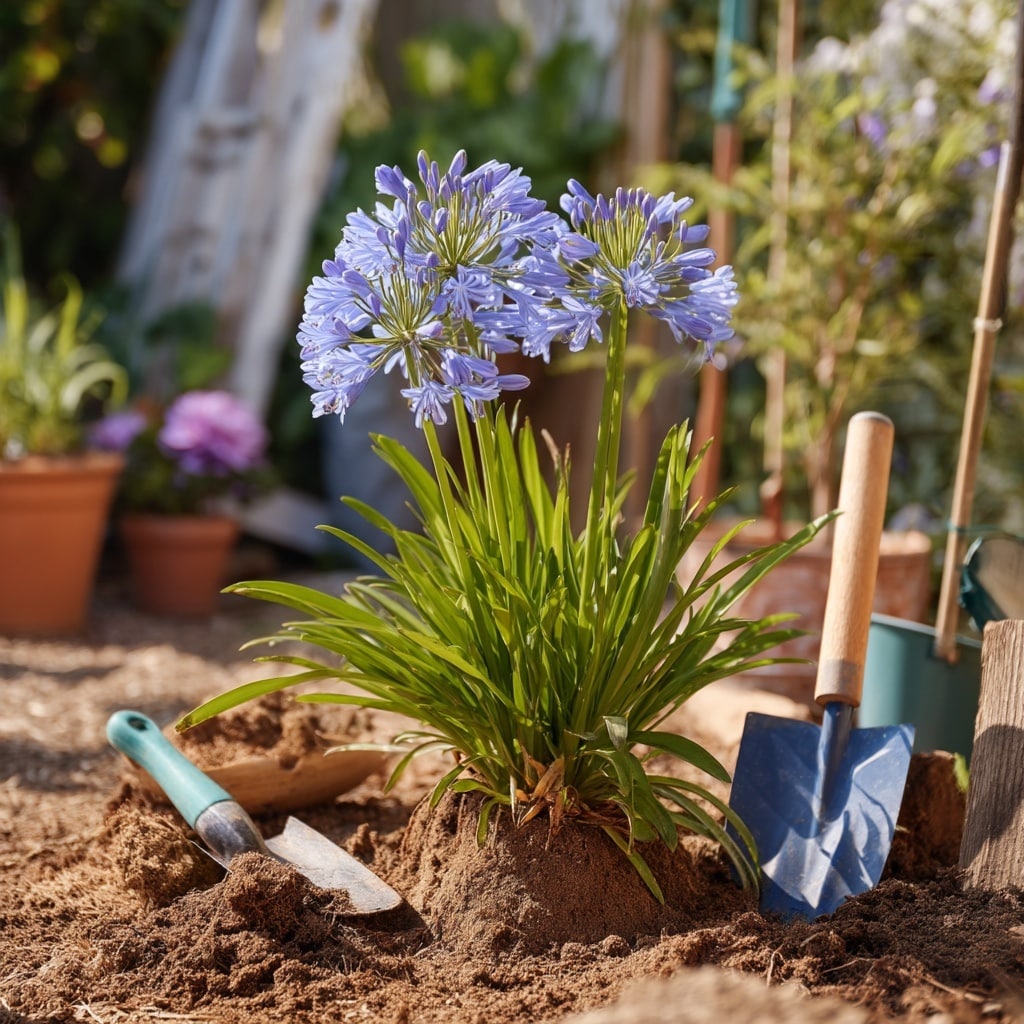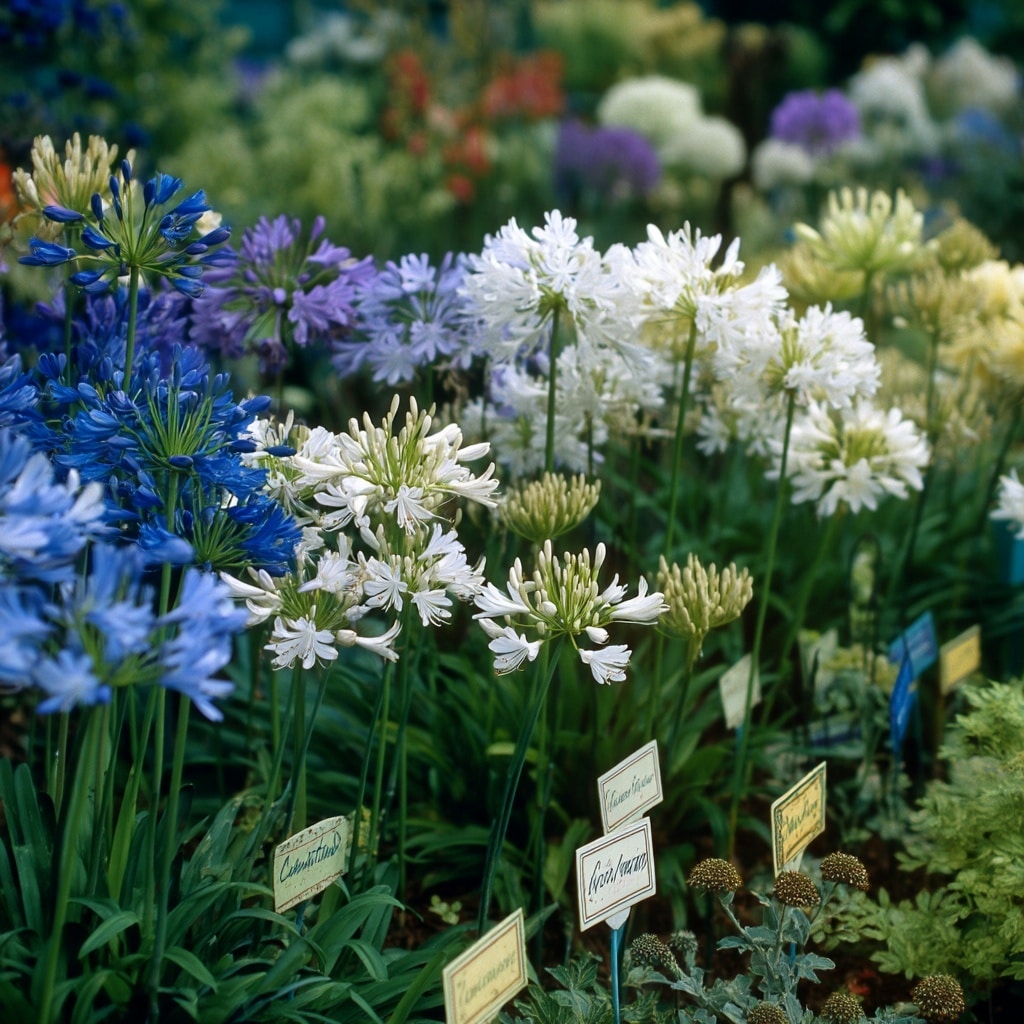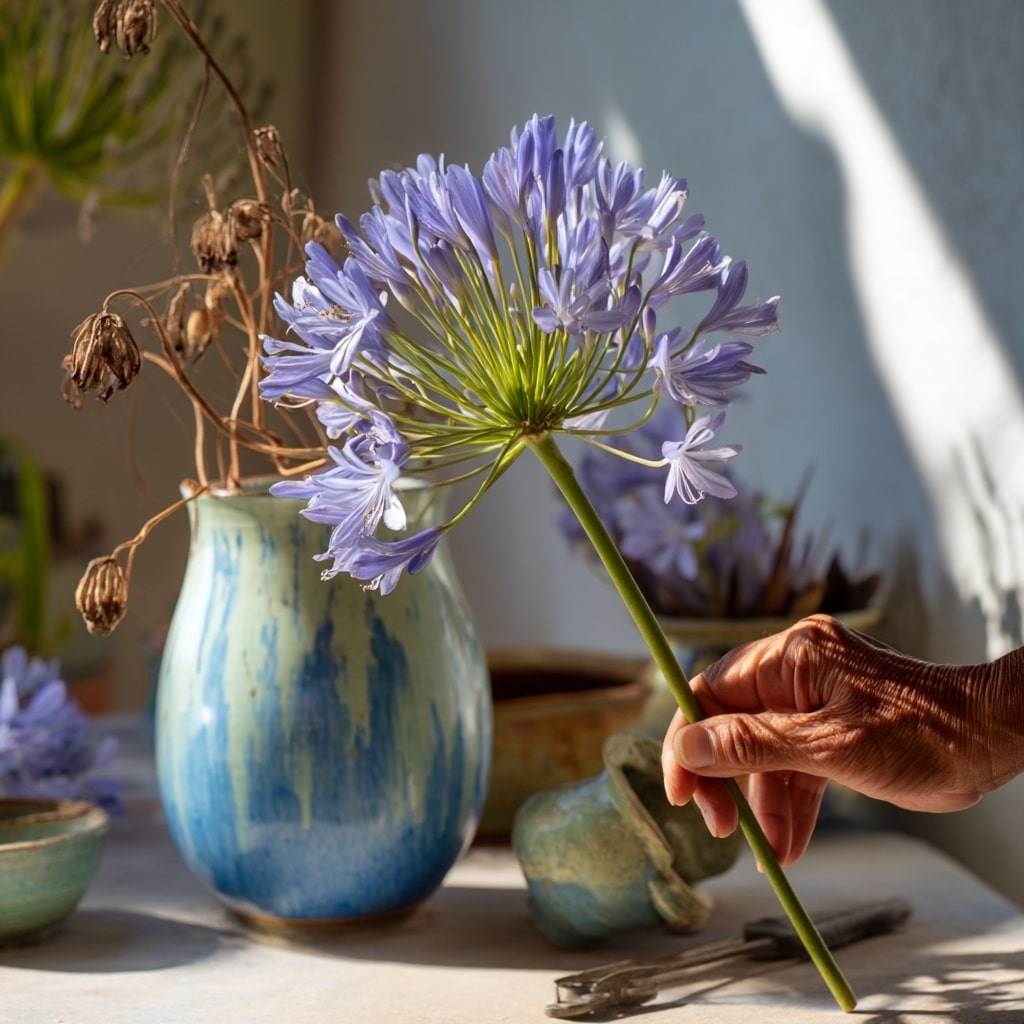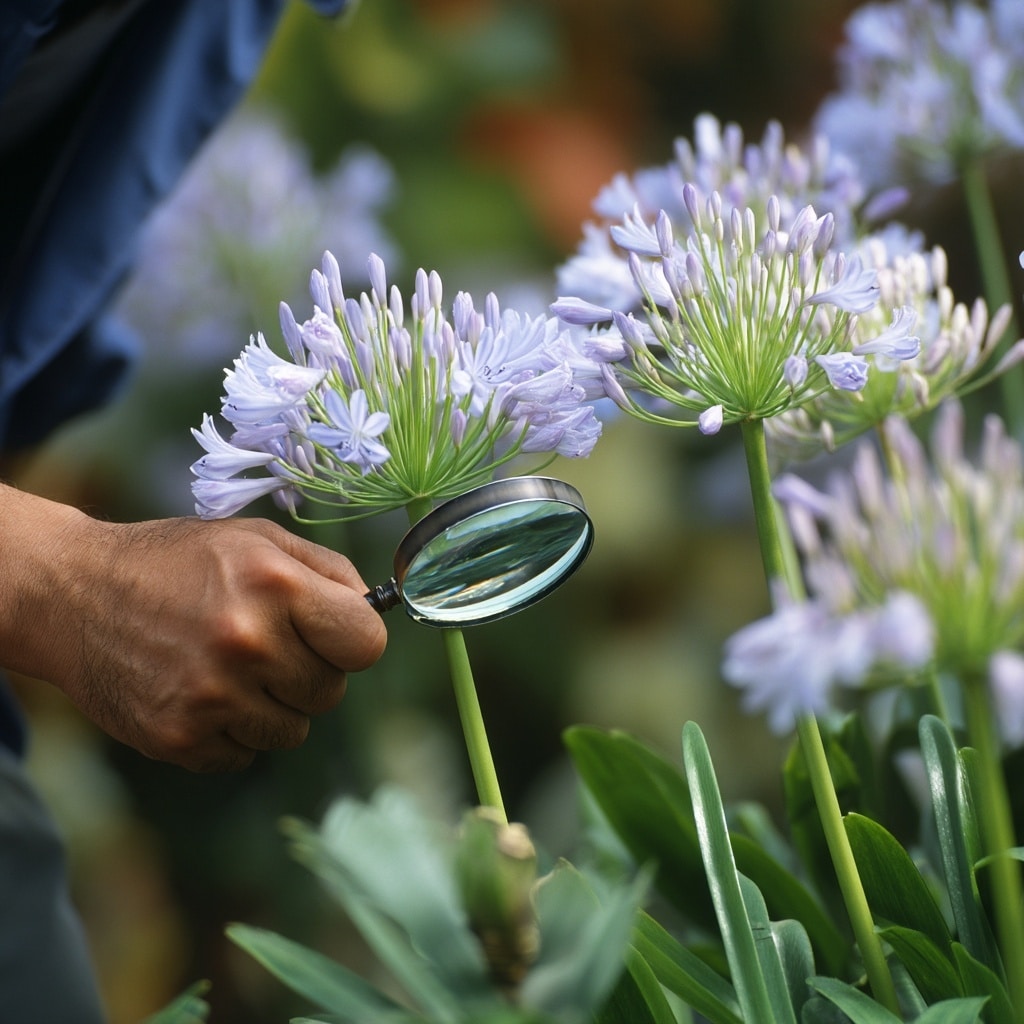Blue lily plants, often known by their botanical name Agapanthus, are a striking and elegant addition to any garden. With tall stems topped by clusters of funnel-shaped blue or white blooms, they bring height, structure, and color to borders, containers, and sunny beds. Despite the common nickname “Lily of the Nile,” these vibrant perennials are native to South Africa—not the Nile River.
Loved for their long-lasting flowers and lush, strappy green leaves, blue lilies are easy to grow and low-maintenance once established. Whether you’re planting them for their bold summer blooms or their architectural foliage, understanding the basics of Agapanthus care ensures you’ll enjoy a showy and healthy display for years to come.
Table of Contents
What Does a Blue Lily Look Like?
The blue lily, or Agapanthus, is a bold yet graceful perennial known for its eye-catching form. Its signature look begins at the base, where glossy, strap-like leaves grow in dense clumps. These deep green leaves create a tidy, grass-like mound that remains attractive even when the plant isn’t in bloom.
Above this base, long, sturdy flower stalks rise between 1 and 4 feet tall, depending on the variety. Each stem is topped with a rounded cluster—or umbel—containing dozens of starry, trumpet-shaped flowers. These blooms typically range in shades from pale sky blue to rich indigo, though white and violet cultivars are also popular.
When planted en masse, blue lilies create a stunning visual rhythm—upright stems topped with floating flower orbs, gently swaying in the breeze. Their form works beautifully in modern and cottage gardens alike, offering both elegance and structure in every season.
Where and How to Plant Blue Lily

To thrive, the blue lily needs a spot that mirrors its sun-loving South African origins. Choose a planting area that receives at least 6 hours of direct sunlight daily—the more sun, the better the blooms. While it can tolerate light shade, insufficient sun often leads to weak stems and fewer flowers.
Blue lilies perform beautifully in borders, raised beds, or large containers. In cooler climates, containers are ideal because they can be moved indoors for winter protection. When planting in the ground, ensure the soil drains well. These plants are highly susceptible to root rot in soggy conditions.
If planting from a rhizome, place it 1 inch deep in spring, in rich, loamy soil or a well-draining potting mix. Containers should be at least 8 to 12 inches wide to allow for root spread. While agapanthus enjoys snug roots (they bloom better when slightly pot-bound), avoid extreme crowding, as it can reduce flowering.
Once planted, water thoroughly and allow the soil to dry slightly between waterings.
How to Grow and Care for Blue Lily

Once established, the blue lily is remarkably easy to care for, making it a favorite among both new and seasoned gardeners. Its main needs are sun, moderate water, and a little seasonal attention.
☀️ Light and Water
For strong growth and vibrant blooms, position your blue lily in full sun. In hotter climates, a bit of afternoon shade is acceptable, especially for container-grown plants. During the first growing season, water regularly to help roots establish. After that, these plants become drought-tolerant, needing only occasional watering in dry spells.
Avoid overwatering—Agapanthus dislikes wet feet. Always check that the soil is dry an inch or two down before watering again.
🌼 Feeding and Fertilizer
Feed blue lilies twice per year:
- Spring: Apply a balanced, slow-release fertilizer to support early growth.
- Midsummer: Use a high-potassium fertilizer (like tomato feed) to promote blooming.
Avoid overfeeding—too much nitrogen can cause lush foliage at the expense of flowers.
❄️ Overwintering Tips
In USDA Zones 7/8 to 11, blue lilies are typically hardy and can remain outdoors with some mulch around the base in fall. In colder zones, move containers to a frost-free garage or greenhouse before the first frost. Evergreen varieties need light and minimal water indoors; deciduous types can be kept dry and dormant.
Pruning and Post-Bloom Care for Blue Lily

After flowering, blue lily plants benefit from a bit of tidy-up to keep them healthy and encourage future blooms. Once flower clusters begin to fade, cut the spent stems back to the base. This prevents the plant from using energy to produce seeds and encourages it to redirect energy toward root and foliage health.
Don’t remove the leaves right away—they continue to photosynthesize and support the plant’s growth even after flowering ends. Only trim off leaves that are yellowing or damaged. For evergreen varieties, remove any unsightly foliage year-round to keep plants looking fresh. In late autumn, deciduous types will naturally die back.
🌿 End-of-Season Clean-Up
- In colder climates, apply a thick mulch layer around outdoor plants to insulate roots.
- For container-grown blue lilies, move them to a frost-free area or wrap pots in fleece.
- If overwintering indoors, reduce watering and avoid feeding until spring returns.
Regular post-bloom care keeps your blue lily vigorous, reduces disease risk, and sets the stage for even more impressive blooms next season.
How to Propagate Blue Lily Plants

Propagating the blue lily is simple, rewarding, and one of the best ways to expand your collection or rejuvenate older plants. While growing from seed is possible, most gardeners prefer division, as it’s faster and more reliable.
✂️ Dividing Established Plants
Every 4–5 years, divide container-grown blue lilies when they become root-bound or when flowering slows. The best times to divide are:
- For evergreen types: Immediately after flowering
- For deciduous types: In early spring before new growth begins
Use a clean, sharp knife to slice the rhizome into sections, ensuring each division has at least one healthy shoot and attached roots. Replant in fresh soil and water thoroughly. Allow up to a year for new divisions to flower.
🌱 Growing from Seed
Though slower, seed propagation offers unique plants—no two seedlings are exactly alike. Sow seeds in spring, ¼ inch deep in a well-draining mix. Germination may take several weeks. Flowering from seed can take 2–5 years, so patience is key.
Propagation helps you maintain vigorous plants and gives you the joy of multiplying your favorite blue lily varieties over time.
Popular Blue Lily Varieties to Grow

With over 600 hybrids and cultivars, the blue lily (Agapanthus) offers a wide range of colors, heights, and bloom types to suit every garden style. These varieties fall into two main categories: evergreen (retain foliage year-round) and deciduous (die back in winter).
🌿 Evergreen Varieties
These tend to be more frost-sensitive and are best suited for mild climates or container growing with winter protection.
- Agapanthus africanus ‘Peter Pan’
Compact (1–2 ft tall), sky-blue flowers, perfect for pots and borders. - Agapanthus ‘Ever Sapphire’
Deep blue blooms, very floriferous, blooms early and reliably. - Agapanthus africanus ‘Albus’
Classic white flowers on tall stems, striking in mass plantings. - Agapanthus praecox ‘Flore Pleno’
Rare double blue flowers, elegant and unusual. - Agapanthus ‘Queen Anne’
Medium-height variety with soft blue flowers and refined structure.
🍃 Deciduous Varieties
Less commonly sold but hardier and more tolerant of cold temperatures.
- Agapanthus ‘Snowball’
Pure white flowers, about 1–2 feet tall, great for bright garden contrast. - Agapanthus ‘Snow Storm’
Tall and bold with large white blooms, thrives in partial sun.
💡 Tip: Dwarf varieties are especially suited to containers, while tall types make excellent focal points in garden beds.
Mixing different types of blue lily allows you to extend the bloom season and create striking contrasts of height and color.
Harvesting Blue Lily Flowers and Seeds

The blue lily isn’t just a garden stunner—it also makes a beautiful, long-lasting cut flower. When properly harvested, the blooms can brighten indoor arrangements for up to 10 days.
🌸 Harvesting Flowers
Wait until the flower cluster is fully open, then use sharp, clean scissors or pruners to cut the stem near its base. Harvesting in the morning helps preserve moisture and freshness. Avoid damaging surrounding foliage or developing buds.
Cut blue lilies pair well with both structured and wildflower-style bouquets, adding height and elegance. Their upright stems and clustered blooms make them ideal for tall vases.
🌱 Collecting Seeds
If you want to grow blue lilies from seed—or simply enjoy the full life cycle—allow a few flower heads to mature and dry out completely on the plant. Once the seed pods turn brown and papery, clip them off and let them dry indoors.
Break open the pods and store the seeds in a paper envelope in a cool, dry place. While seed-grown plants take years to flower, they offer genetic variety and are a fun project for patient gardeners.
Harvesting adds another layer of enjoyment to growing blue lily, whether you’re decorating your home or planning next season’s planting.
Pests, Problems, and How to Get Blue Lily to Bloom Better

Though the blue lily is generally low-maintenance, it isn’t immune to challenges. Luckily, most issues are easy to fix with a few proactive steps.
🦠 Common Pests and Diseases
- Slugs and Snails – Chew on leaves, especially in damp weather. Use copper tape or organic slug bait to deter them.
- Mealybugs and Thrips – Can infest indoor or greenhouse plants. Remove with insecticidal soap or neem oil.
- Spider Mites – Thrive in dry, dusty conditions. Boost humidity or spray foliage with water and mild soap.
- Botrytis Blight (Gray Mold) – A fungal issue that causes flower and leaf rot. Improve air circulation and remove infected parts.
🌼 Why Blue Lily Isn’t Blooming
If your blue lily isn’t flowering as expected, consider these common causes:
- Too Much Shade – Agapanthus needs full sun (6+ hours daily) to bloom well. Move pots or choose a sunnier location.
- Overwatering or Poor Drainage – Soggy roots lead to stress and fewer blooms.
- Not Pot-Bound Enough – These plants bloom best when slightly crowded in containers.
- Lack of Winter Chill (for deciduous types) – Some need a cool dormancy period to trigger spring blooming.
- Nutrient Imbalance – Avoid excess nitrogen; instead, feed with a high-potassium fertilizer in spring and midsummer.
With the right care, your blue lily will reward you with a spectacular floral display that returns each year with even more vigor.
Conclusion: A Stunning, Sun-Loving Star for Every Garden
If you’re looking to add bold color, graceful form, and easy elegance to your outdoor space, the blue lily is an unbeatable choice. With proper sunlight, well-draining soil, and occasional feeding, Agapanthus offers months of stunning blooms with very little maintenance.
Whether grown in containers, borders, or as cut flowers, blue lilies bring timeless charm and structure to your garden. By dividing established plants and giving them the right seasonal care, you’ll enjoy bigger, better blooms each year.
Strong, stylish, and surprisingly tough — the blue lily is a garden gem worth growing.




